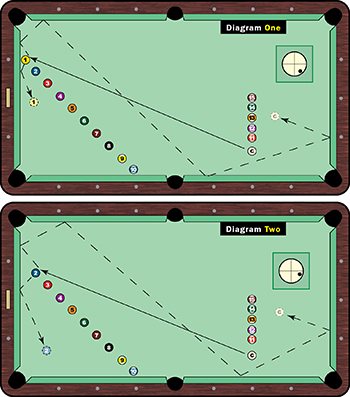Learn to “thin” the object ball to improve your safety game.
Safeties win games. It’s that simple.
So, this month let’s explore a 10-ball safety drill that puts a premium on being able to hit the thin edge of an object ball. This drill will also teach you about deflection from your shaft and tip, so plan on taking some time to understand how much to allow for deflection.
More important than deflection, however, is that this drill will teach you a lot about thinning balls. So many players, even pros, struggle with this shot and play it wrong. They are tough shots, for sure, but with practice you will understand and trust the spin and your stroke so much more.
The drill layout is shown in Diagram One. The rule for pros is that the cue ball must hit four rails each shot. Amateurs have a three-rail minimum. You are not allowed to contact another ball or pocket the object ball. Of course, your shot must also result in a snooker behind the wall of balls 11-15.
If you fail, restart the process and see if you can continually improve your result.

I play most of these shots with low English and spin because it kills the object ball speed more than playing with follow. Also, with follow the cue ball gathers speed. Low spin gives you more control and takes the scratch out of the equation. In essence, you’re swerving the cue ball into the object ball with low English, which in turn throws the cue ball wider and kills the object ball. Whenever I practice, I play thin edge shots to feel the stroke and get my sighting down.
On this drill, I play the 1 ball with low right English. I aim for about a quarter ball on the righthand side. The deflection takes, and I catch the thin edge.
For the 2, 3, 4 and 5 balls, I hit the cue ball just below center with right English. This doesn’t throw the cue ball as much, which makes it an easier shot than the shot on the 1 ball. There is just enough throw to contact the object ball wherever you want. You don’t need to play these shots as thin.
For the 6, 7, 8, 9 and 10 balls, I go back to low right English, but slightly less spin than I use on the 1 ball. I use just a tip of right. I don’t need to deflect the cue ball as much, so I hit the object ball where I aim.
Again, this is a great practice drill. It will help you understand the physics of the cue ball and how to be creative with shots that are not natural.





